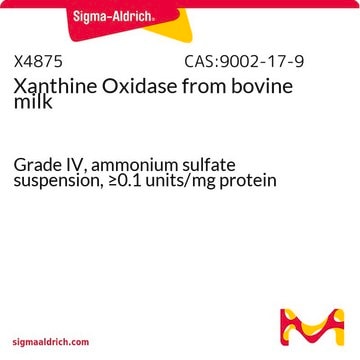X1875
Xanthine Oxidase from bovine milk
Grade I, ammonium sulfate suspension, ≥0.4 units/mg protein
Synonyme(s) :
XOD, Xanthine:oxygen oxidoreductase
About This Item
Produits recommandés
Type
Grade I
Forme
ammonium sulfate suspension
Activité spécifique
≥0.4 units/mg protein
Activité étrangère
uricase ≤0.5%
Conditions d'expédition
wet ice
Température de stockage
2-8°C
Vous recherchez des produits similaires ? Visite Guide de comparaison des produits
Description générale
Application
- in the preparation of xanthine oxidase (XO) solution for 5-(diethoxyphosphoryl)-5-methyl-1-pyrroline-N-oxide (DEPMPO)-spin trapping assay
- in in vitro XO assay for screening Vietnamese medicinal plants for XO inhibitory activity
- as a standard to determine XO activity
- as a standard to test the synergistic effect of docosahexaenoic acid (DHA)
Actions biochimiques/physiologiques
Définition de l'unité
Forme physique
Remarque sur l'analyse
Mention d'avertissement
Danger
Mentions de danger
Conseils de prudence
Classification des risques
Resp. Sens. 1
Code de la classe de stockage
11 - Combustible Solids
Classe de danger pour l'eau (WGK)
WGK 3
Point d'éclair (°F)
Not applicable
Point d'éclair (°C)
Not applicable
Équipement de protection individuelle
Eyeshields, Gloves, type N95 (US)
Certificats d'analyse (COA)
Recherchez un Certificats d'analyse (COA) en saisissant le numéro de lot du produit. Les numéros de lot figurent sur l'étiquette du produit après les mots "Lot" ou "Batch".
Déjà en possession de ce produit ?
Retrouvez la documentation relative aux produits que vous avez récemment achetés dans la Bibliothèque de documents.
Les clients ont également consulté
Articles
Instructions for working with enzymes supplied as ammonium sulfate suspensions
Protocoles
Enzymatic Assay of Superoxide Dismutase
Notre équipe de scientifiques dispose d'une expérience dans tous les secteurs de la recherche, notamment en sciences de la vie, science des matériaux, synthèse chimique, chromatographie, analyse et dans de nombreux autres domaines..
Contacter notre Service technique












